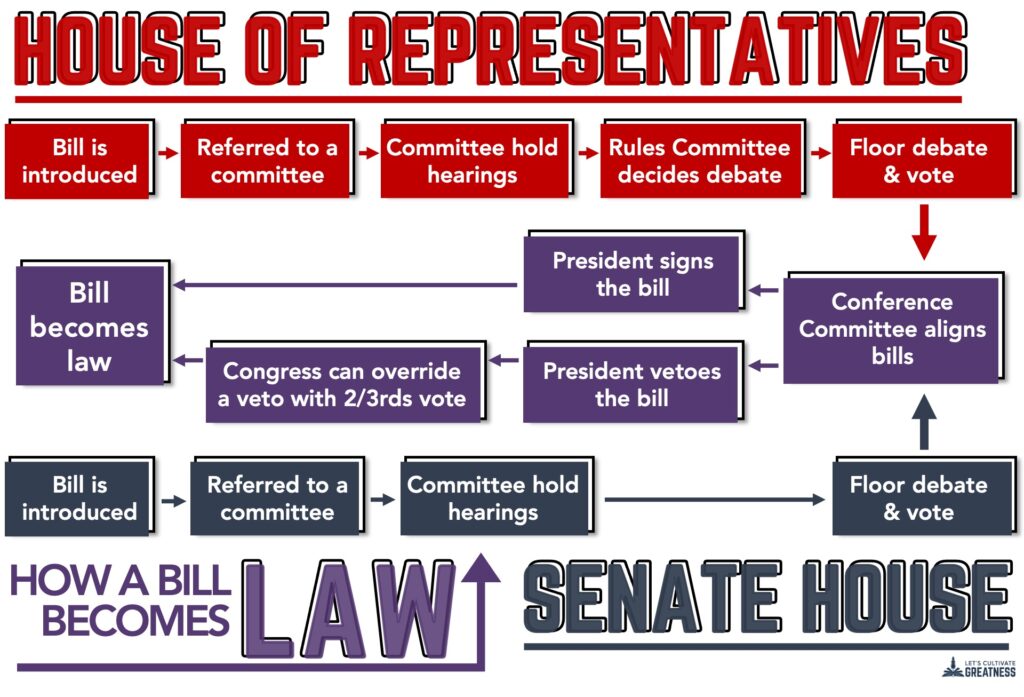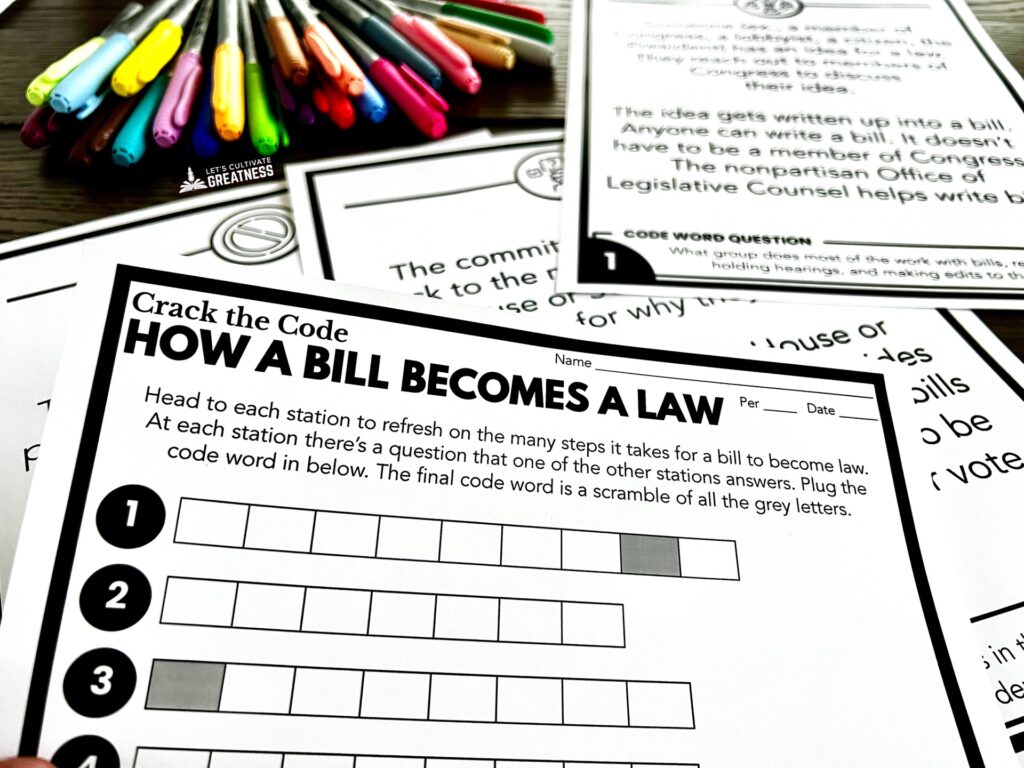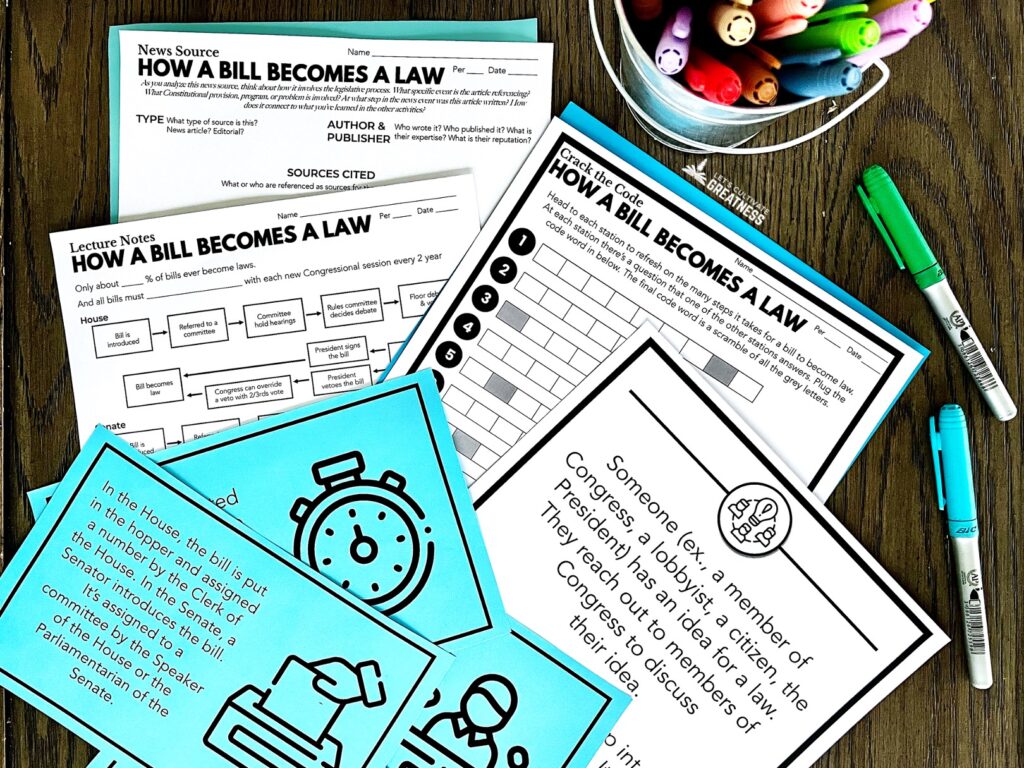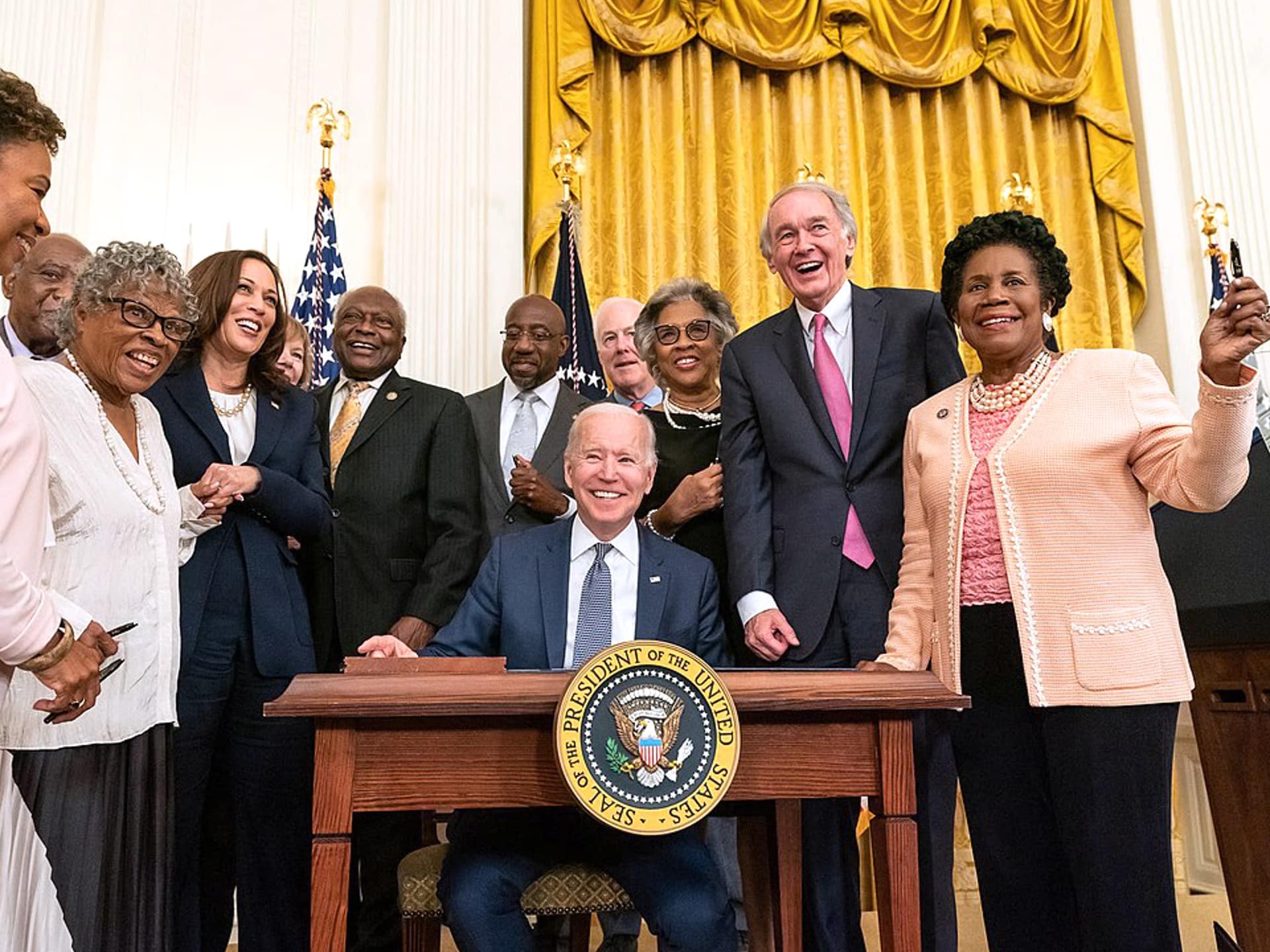There’s no teaching civics and government without a lesson on how a bill becomes a law, but it’s one that’s often left to verbalizing the steps and displaying a flowchart.
How in the world do you make the legislative process engaging?
When you really break it down into each minuscule step a bill goes through, it’s a few dozen. So, it can feel like it’s never-ending.
And then, what do you have students do after you’ve covered the steps? The first step of introducing content like this is always easy—give students a lecture, a textbook reading, or a video to watch. But then what?
Over the years, I’ve flushed out my once-boring how a bill becomes a law lecture to include collaborative activities. Students now gain a deeper understanding of this arduous process with much more real-world context.
Below, I share my lesson sequence for teaching how Congress passes bills into law in my high school Civics and Government class. But first, let’s go over the basics of Congress and the legislative process.
What does the Legislative Branch Do?
While Congress has been granted a few additional duties, its primary function is to make laws—decisions that will “provide for the common defense and the general welfare” of the American people.
Members of Congress are entrusted to work on behalf of their constituents to make these decisions. That’s because lawmaking is so time-consuming and involves so much expertise. There’s no way people can do this important work themselves.
In essence, this branch is the core of a representative democracy. If the people dislike their Congressional Representative or Senators’ decisions, they can vote them out in the next election.
What are the Steps of How Bills Become Law?
This topic can be explained in a few broad steps or spliced into countless micro steps. That’s why you’ll never see an agreed-upon number. You’ll need to decide how granular you want to go, depending on your students’ levels and the time you have.
Of course, the most interesting parts of any topic usually live in the details, so be sure to zoom in a little with each major step.
These are the six major components of how a bill becomes law:
- A bill is drafted and introduced in either the House or the Senate
- It’s assigned to a committee, which closely examines, debates, and refines the bill
- The bill goes to the entire House or Senate for discussion and a vote on the chamber floor
- If it passes in one chamber, it goes to the other one to undergo all the same steps
- The two chambers work together to make the bills identical
- That single bill goes to the President, who has the power to sign it into law or veto it

Because I teach high school seniors, I break them out into a few dozen total steps to include some of the real-life partisan actions that happen. Again, it’s in those “steps” that are missing from the textbook flowchart where the intrigue and big takeaways live.
For example, the fact that whichever political party has the majority of that chamber runs all the committees and decides what bills even get on the calendar. Mentioning this step leads to an authentic and intriguing question, “Is that democracy in action or a gross violation?”
If you’re unfamiliar with these unofficial steps, this Politico article and this Civics 101 podcast episode offer great insight into the backroom dealings of the modern-day legislative process.
Lesson Ideas for Teaching the Legislative Process
Since there’s so much more to this process, you really need to go beyond the textbook flowchart. I use this topic as a chance to weave in what Congress is currently working on and details about our local members of Congress.
I spend two or three class periods doing the activities I describe below. You can head to my store for all these in a done-for-you lesson kit.
1. Examine the Constitutional Wording
First, give students the text of Article I, Section 7, where the basic process is listed. Never skip the opportunity to bring the original source to students!
I weave the text in chunks into my lecture slides as we go through the steps, but you could also hand out hard copies.
2. Provide Visual Examples
I like to do this in two ways. First, my lecture slides include photos and visuals of Congress in action with recent or landmark laws.
For example, a photo of the President in the most recent State of the Union Address telling Congress what laws they want to see on their desk.
Second, on students’ lecture notes and in the next activity, I include clip art representing and reinforcing each step. This is crucial for your lower-level and ELL students. I always find the icons I’ve needed at Flaticon.com, which are free downloads!
3. Practice Sorting the Order
A topic like this is perfect for a sorting card activity after lecturing. I break the process into a couple dozen steps that go one to a slip.
I include images on the slips for reinforcement, but you could also use them for an added matching element. Cut out slips with just the images and others with just the text of the steps. This would be a great ELL support.

I’ve done this activity in two ways. One, in small groups, where each group gets a scrambled stack of slips to sort at their table. Or I have given out half-sheet versions—one to each student—to organize themselves into a human timeline.
If your class size is large enough, two timeline groups can race to get in order the fastest.
4. Incorporate a Game
Now that students have been exposed to the steps a few different ways, bringing in a bit of competition helps solidify their learning. This is perfect to do on the next day after introducing the topic.
I took the same text I typed up for the slips and turned them into a dozen stations to place around the room. To make it into a game, I put questions at the bottom of each station that are answered on the other stations.
For example, on the sheet that talks about the President signing or vetoing a bill, I have a question about what the Senate filibuster is. Since students are already familiar with the content, they can jump around among the stations without issue.

As a fun bonus, I make a code word challenge by scrambling some select letters from the answers. The team that cracks the final code first gets a small prize.
I generally don’t do games very often, but doing one for this little bit of somewhat dry topic seems to work well.
5. Examine Current Legislation
This is easy to do in a few different ways. First, you can start each day of your Legislative Branch unit by pulling up either a news outlet or the official House.gov and Senate.gov pages and sharing what legislation Congress is currently working on. This is a great way to show how Congress usually doesn’t function as seamlessly as the flowcharts imply.
Or you can make it more formal by having students read and analyze a news article.
A good in-between is bringing in a political cartoon or two depicting current actions and attitudes about Congress. I like to find cartoons on Daryl Cagle’s cartoon database. Download my free Political Cartoon Analysis Kit if you need an easy framework.
I also recommend showing the most recent Gallup polling on Congress’s approval rating. This is usually pretty eye-opening!
And that’s it! You’ve given the legislative process solid coverage in just two or three class periods. All these options are included in my ready-made kit.

Grab my How a Bill Becomes Law activity kit if you want a done-for-you lesson sequence to cover the basics of the Legislative Branch for your Civics or Government class in just a few class periods.
Feature image photo credit: Chandler West, Official White House photo of President Biden signing the Juneteenth National Independence Day Act in 2021








